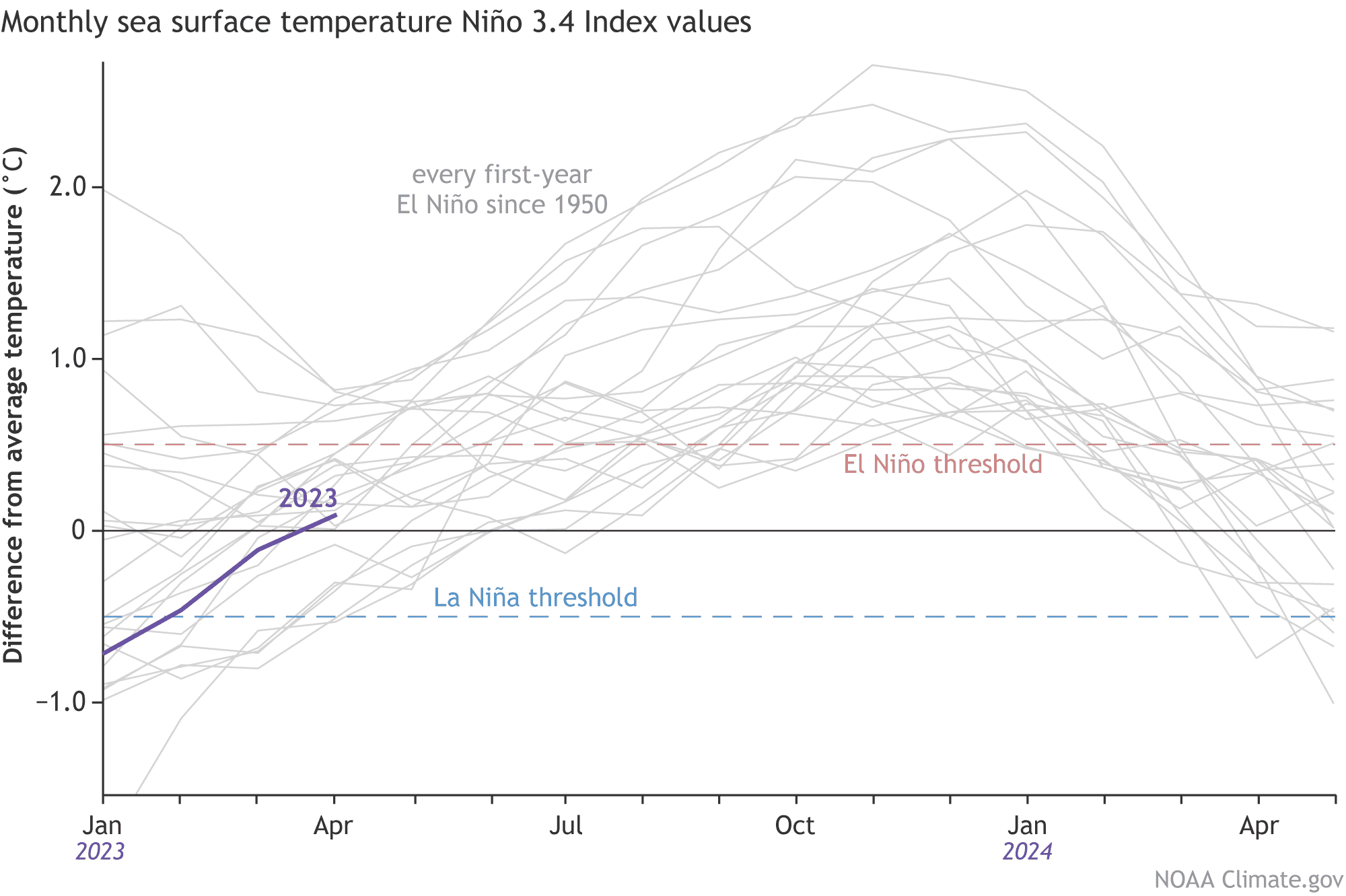
The tropical Pacific sure knows how to get out of a rut! Just two months after declaring the demise of an almost interminable La Niña, above-average surface temperatures have reclaimed the tropical Pacific, and temperatures in the central-eastern Pacific are expected to continue to rise. Consequently, an El Niño Watch remains in place, with El Niño conditions likely to develop within the next couple of months and then persisting (greater than 90% chance) into the winter.
We care about the potential development of El Niño—the warm phase of ENSO (El Niño/Southern Oscillation, the whole El Niño-La Niña system)—because of the cascade of global impacts that arise from its occurrence, including the expected temperature and precipitation patterns shown here. We’ll revisit many of these impacts in the coming months, but we’ll start by focusing on all the details of these rapidly developing conditions in the tropical Pacific.
On the doorstep
According to ERSSTv5 (our most consistent historical dataset), the April average sea surface temperature in the Niño-3.4 region (our primary monitoring region for ENSO) was 0.1 °C above the long-term (1991–2020) average. This value is up 0.2 °C from March and is the first time the monthly Niño-3.4 temperature was warmer than average since April 2020.
When we zoom into the weekly time frame, we find that the latest Niño-3.4 measurement from our highest-resolution dataset (OISSTv2.1) was 0.4 °C above the long-term average, even higher than the latest monthly average. This is just a mere 0.1 °C away from the 0.5 °C threshold that is necessary (but not sufficient!) for declaring El Niño conditions. Subsurface ocean temperatures in the tropical Pacific also increased over the past month, providing a source of warmer water that can sustain a developing El Niño. How can La Niña seem like a distant memory so quickly?
Although the tropical Pacific Ocean looks ready to burst through that door to El Niño, the tropical atmosphere seems a bit more hesitant, remaining firmly in ENSO-neutral territory. As in March, the April Southern Oscillation Index and the Equatorial Southern Oscillation Index were close to zero, indicating that the Walker circulation remains at near-average strength. For El Niño conditions, we would expect negative values of these indexes, which would indicate (1) a weakening in the surface pressure difference that normally exists between the western and central-eastern Pacific and (2) a reduction of the east-to-west surface trade winds that are the key component of the Walker circulation. (For La Niña conditions, we get the opposite – positive index values indicating a strengthened Walker circulation and stronger east-to-west trade winds across the tropical Pacific Ocean.)
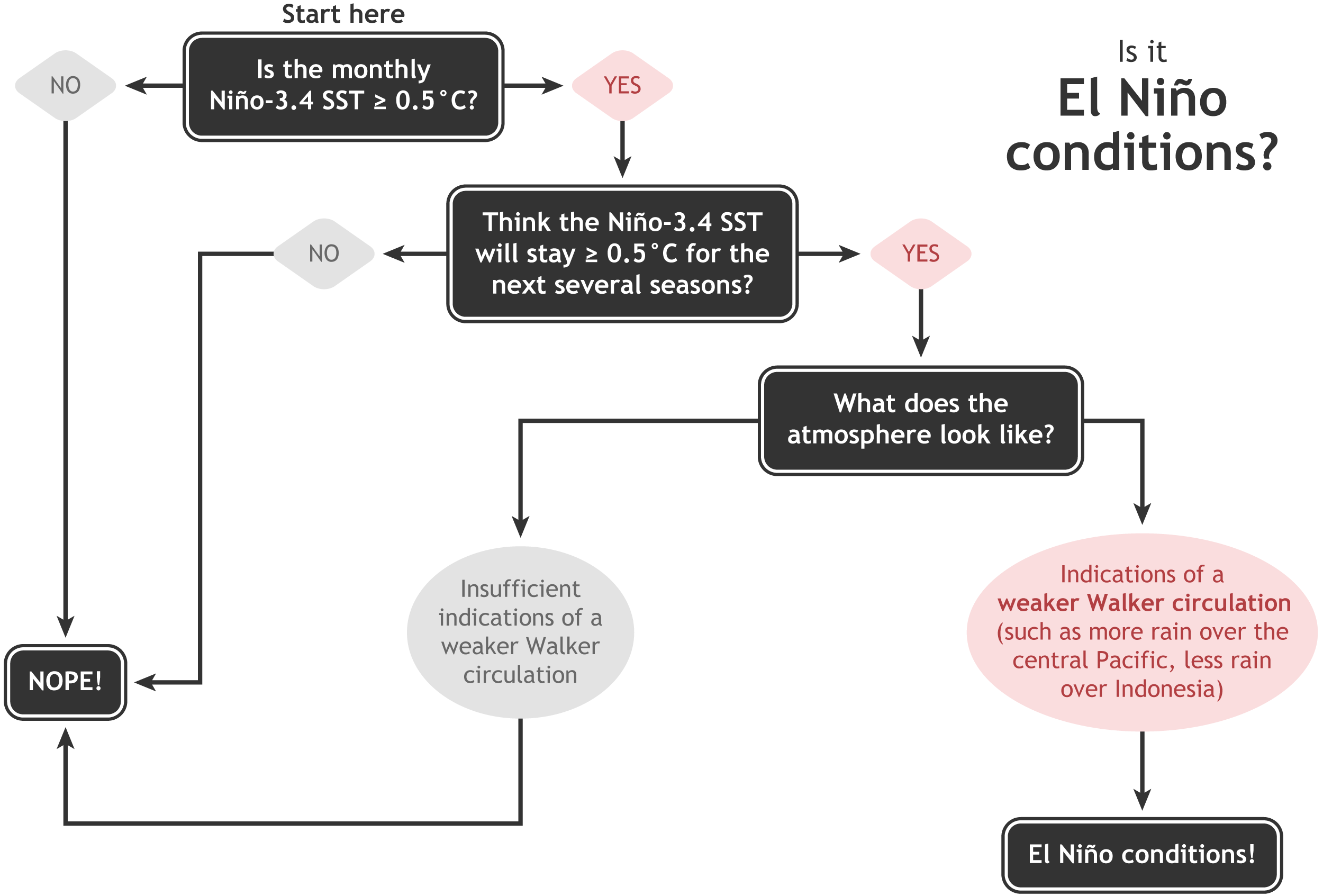
Note that even if the monthly average Niño-3.4 index soon exceeds the 0.5 °C threshold for El Niño, forecasters will not declare the onset of El Niño unless the tropical atmosphere is clearly responding in the expected way, including a weakening of the Walker circulation.
Peering ahead
Forecasters have high confidence in an upcoming El Niño not only because of the rapidly changing tropical Pacific Ocean conditions but also because of the strong agreement from the latest computer model predictions. The current forecast from the North American Multi-Model Ensemble (NMME), a set of state-of-the-art computer climate models, indicates that the Niño-3.4 sea surface temperature is very likely to climb above the El Niño threshold within a couple of months and remain in El Niño territory for the remainder of the forecast period.
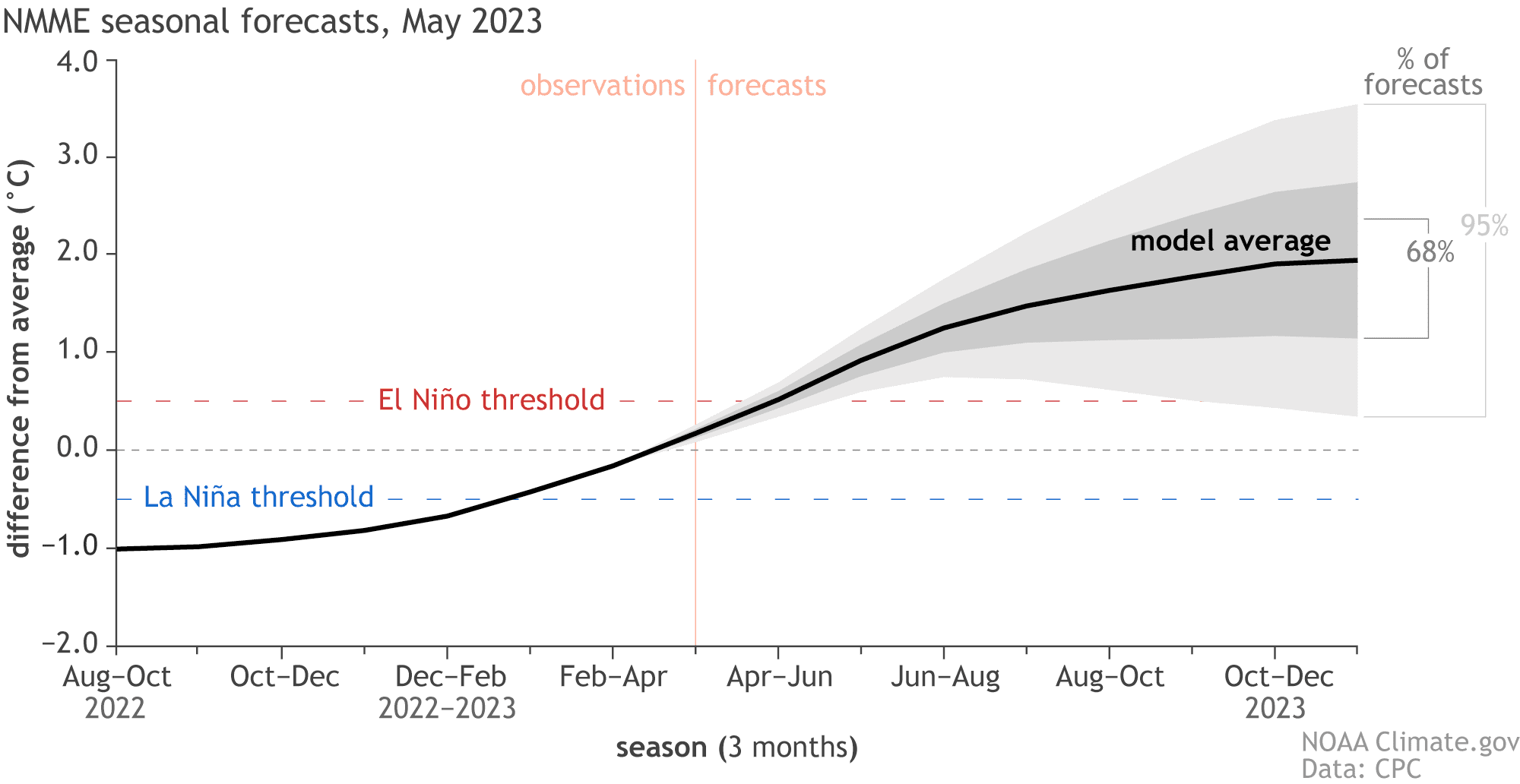
In short, the signs of El Niño development we saw last month have only grown stronger this month. Additionally, we’ve pushed one more month through the dreaded spring predictability barrier (also check out here, here, and Michelle’s latest post here). Taken together, these signals have allowed forecasters to increase their forecast confidence this month, with the likelihood of El Niño approaching 90% by summer and exceeding 90% through next fall and winter.
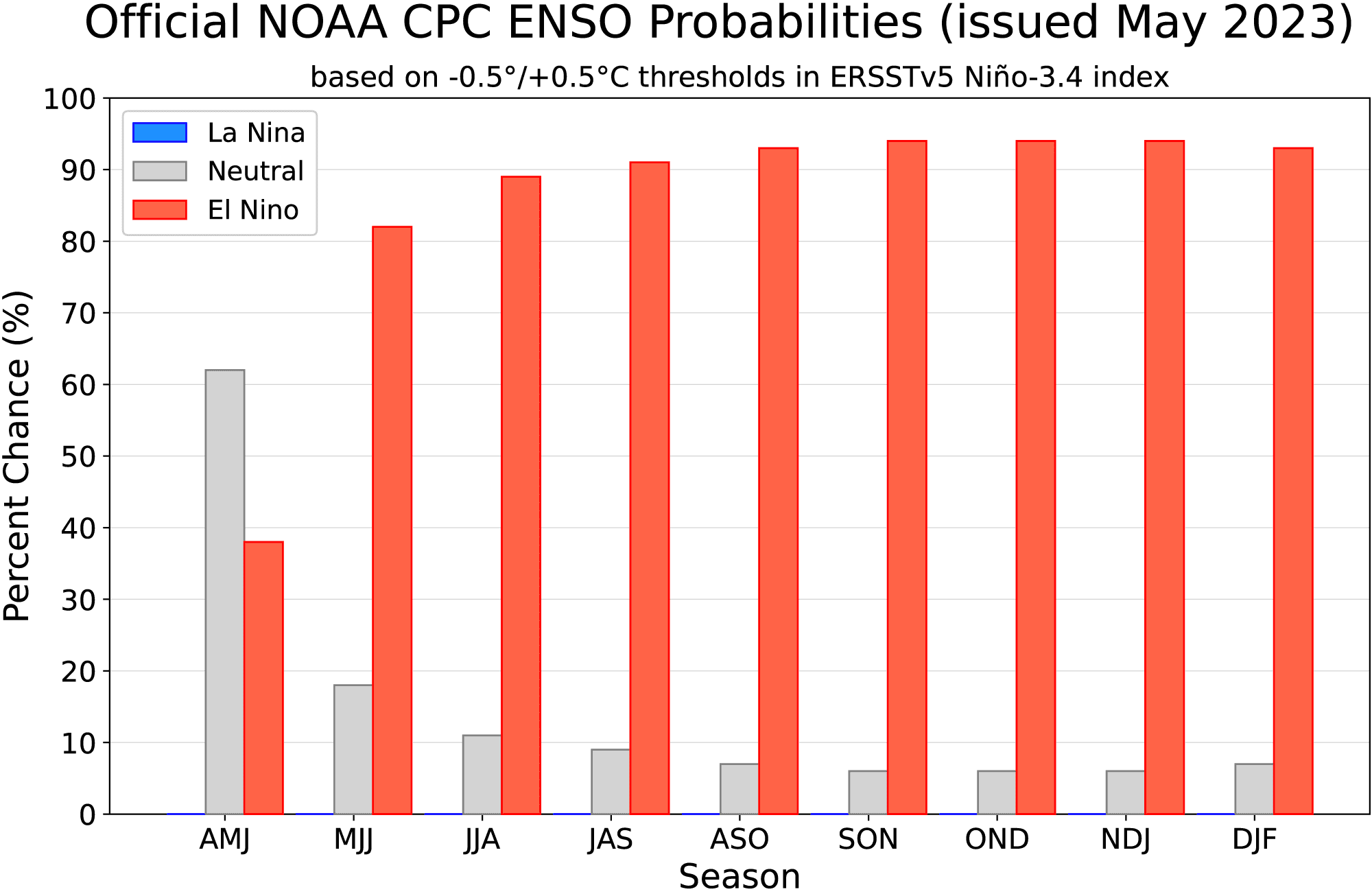
The possibility of a significant El Niño is also growing. Following the method described in Tom’s post, the current chance for a strong El Niño (Niño-3.4 index greater than 1.5 °C) is approximately 55%, which is up almost 15% since last month. We may have a better handle on the potential strength of this event, assuming it develops (still a 5-10% chance it doesn’t!), once we fully get past the spring predictability barrier.
Global simmering
Warm ocean conditions are not just limited to the tropical Pacific. Despite some unusually cold ocean temperatures off the West Coast of the U.S., the remarkably warm global ocean has grabbed recent headlines.
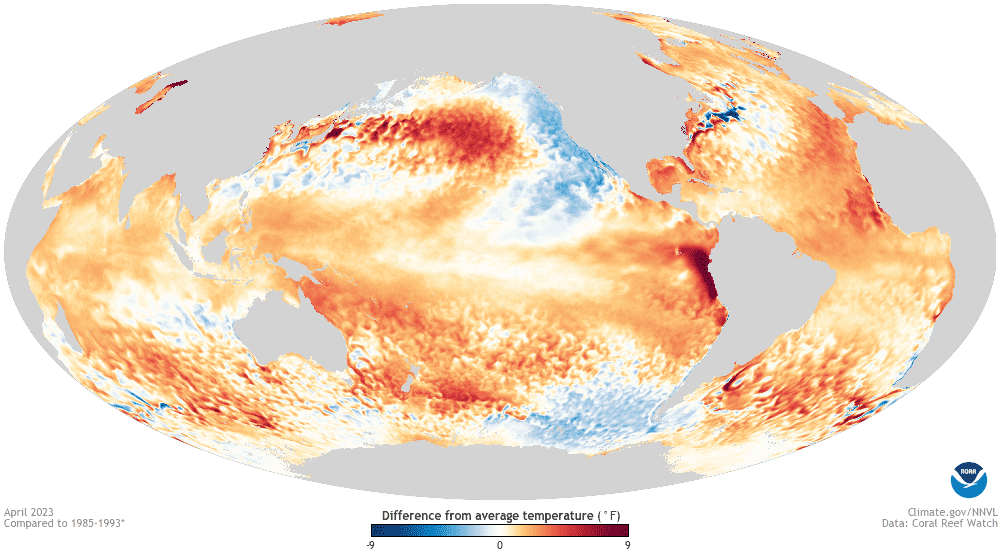
For some additional perspective on this widespread warmth, I reached out to Dr. Boyin Huang, an oceanographer at the National Centers for Environmental Information with expertise in sea surface temperature reconstructions. Dr. Huang kindly provided the following plots of near-globally averaged sea surface temperature time series for two of our most used sea surface temperature datasets, monthly ERSSTv5, and daily OISSTv2.1.
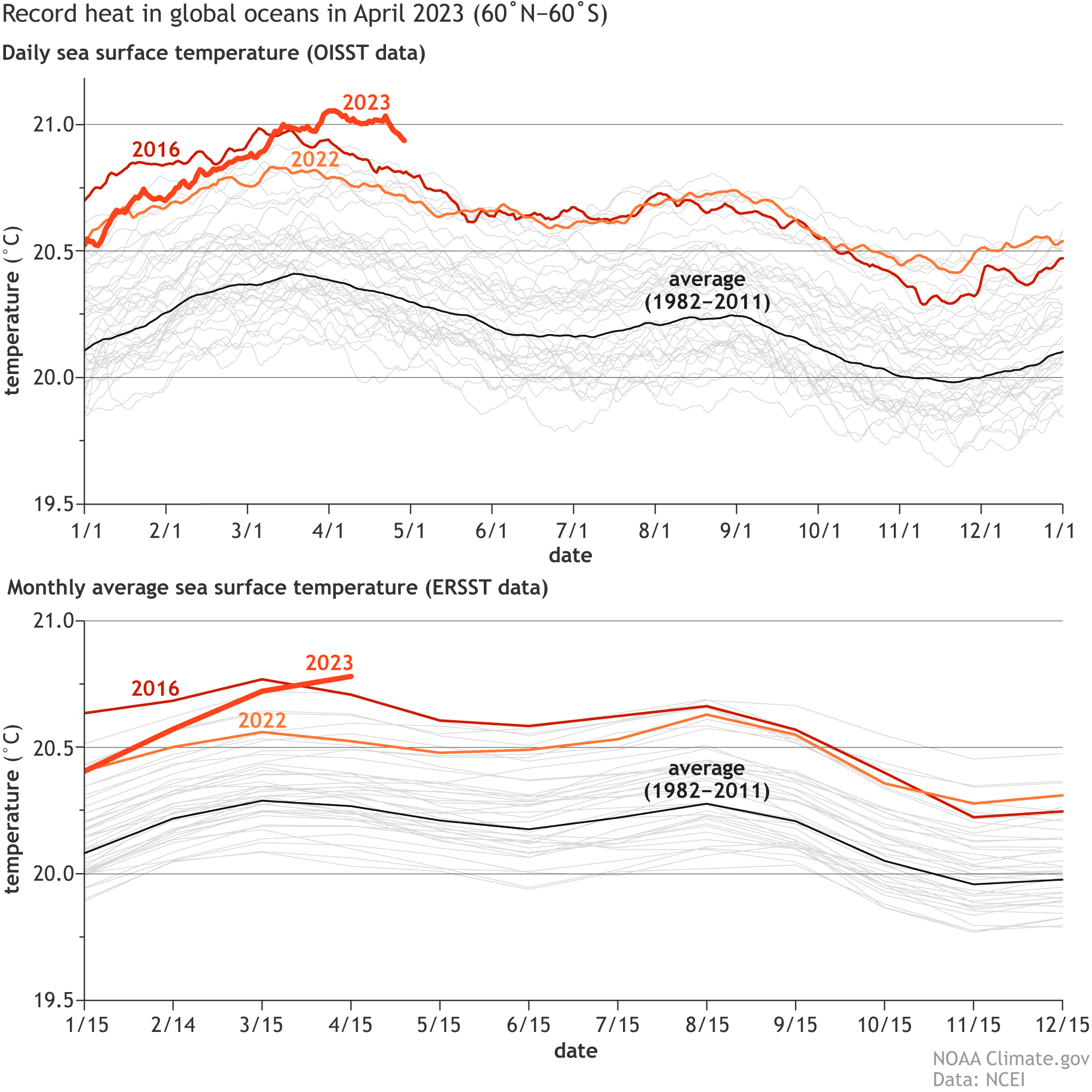
First, we note that while the two datasets are not identical, as Tom pointed out way back when, both the ERSST and OISST datasets confirm that the global oceans are currently sizzling. However, they do have minor disagreements about record warmth. Although the global (non-polar) ocean surface temperatures have been warmer than at any point over the past 40 years in the OISST dataset since mid-March, the ERSST dataset has trailed the record warmth of 2016, at least until recently. However, Dr. Huang confirms a point of agreement: both datasets indicate that the global ocean surface was warmer in April 2023 than in any previous April.
How would a developing El Niño relate to the global ocean temperatures? First, as Emily noted last month, the global average temperature tends to be higher in El Niño years than in La Niña or ENSO-neutral years. Given how warm the oceans are already, a developing El Niño would only increase the chance of record-breaking global ocean temperatures (and global average temperature over both ocean and land), which likely would have important ecological consequences, including for fish and corals.
Another factor to consider is that the widespread ocean warmth may make it a little more challenging for the warm temperatures in the central-eastern equatorial Pacific to induce a tropical atmospheric response (maybe a reason for the current ENSO-neutral-looking tropical atmosphere?) The reason is that the response of the tropical atmosphere depends on surface temperatures in the central-eastern equatorial Pacific relative to the surrounding regions. If those surrounding tropical regions are also warmer than average, then the bar is even higher for the Niño-3.4 region surface temperature anomalies to induce an atmospheric response (see footnote).
The bottom line is that in terms of a push on the tropical atmosphere, we need to consider that the Niño-3.4 index may punch below its weight while it’s hovering in borderline El Niño territory, as it is now. However, if the central-eastern Pacific continues to warm up, we can expect that the atmosphere will feel that push eventually.
Coming Up
You probably noticed that you aren’t being treated to the ENSO update eloquence that Emily usually provides each month. Don’t worry – Emily will be back later this month with a post talking about our favorite blend of computer prediction models, the NMME. Also, be sure to check out NOAA’s outlook for the 2023 hurricane season that comes out in just a couple of weeks (May 25th). One of the biggest implications of developing El Niño in the shorter term is its potential influence on the Atlantic and Pacific hurricane seasons. In brief, Atlantic hurricane seasons are less active during El Niño, while the Pacific season is often enhanced. That means this month’s ENSO forecast is likely one of the factors that will be considered in the hurricane outlook. In the meantime, keep your eyes peeled on the tropics, and don’t blink – conditions are evolving quickly!
Footnote
- This issue is why some, including Michelle of this blog, have advocated the monitoring of a relative Niño-3.4 or relative Oceanic Niño Index (RONI). The NOAA Climate Prediction Center monitors the RONI here. The RONI is simply our standard ONI (3-month average Niño-3.4 sea surface temperature anomaly) with the tropical average sea surface temperature subtracted. Such an index is less sensitive to a warming climate and, consistent with some of my earlier research, is more closely connected with changes in the tropical atmosphere than the standard ONI.
This post first appeared on the climate.gov ENSO Blog and was written by Nat Johnson.